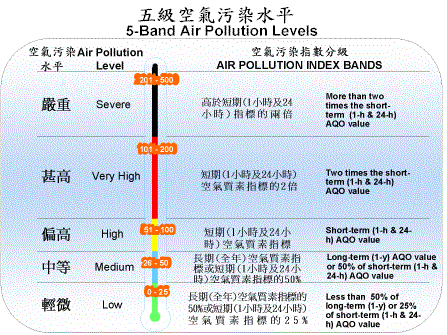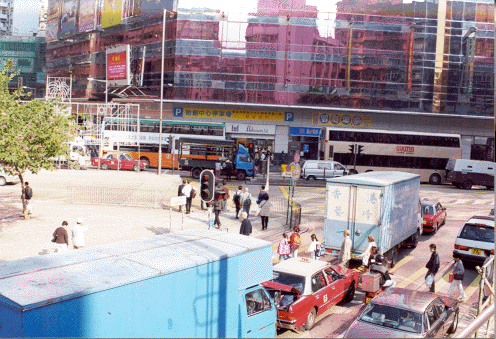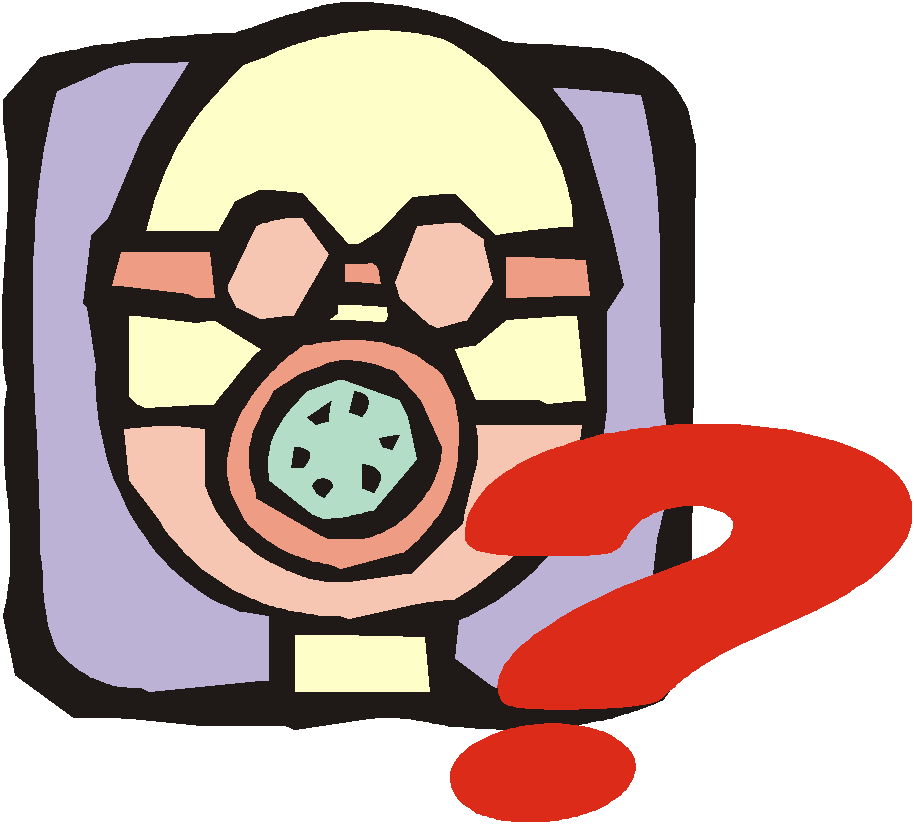 |
QUESTIONS
AND ANSWERS ON THE AIR POLLUTION INDEX AND FORECAST SYSTEM
1.
What is the Air Pollution Index (API)?
2.
What purpose does the API and Forecast System serve?
3.
How is an API calculated and forecasted?
4.
Where can I get the latest APIs and the forecast?
5.
What does the API mean to me?
6.
Does the API reflect the air pollution level for a particular hour
or a longer period?
7.
What are the health implications associated with the different API
bands?
8.
What is the General API and the Roadside API?
9.
Where are the General and the Roadside API stations?
10.
Which one of the APIs is more relevant to me - General or Roadside?
11.
Which General APIs should I refer to if no API is report for the
district I am living in?
12.
Is the API an average of the pollution levels measured at a monitoring
station?
13.
Are there any other countries using the same or a similar API system?
14.
What should I do if the hourly API or its forecast is higher than
100?
15.
What precautionary measures should I take if the Roadside API is
greater than 100?
16.
Do I need to do anything when the API is between 51 and 100 in the
"high" band?
17.
The visibility can be quite poor on days with API higher than 100.
Is visibility a better indicator of our air pollution than the API?
18.
Are air cleaning devices useful to reduce the air pollution at home
during unhealthy air pollution incidents?
19.
Is wearing masks useful when the API is higher than 100?
20.
What can I do if I still have other queries or require further information
on API?
|
1.
What is an Air Pollution Index (API)?

An API
comes from transforming many complicated air quality data
measured at an air quality monitoring station into a single
number ranging from 0 to 500, for the easy understanding of
the public. Depending on the type of air quality monitoring
station it relates, an API can either be a General API or
a Roadside API.
The range
of an API is divided into five bands: Low (0 to 25), Medium
(26 to 50), High (51 to 100), Very High (101 to 200) and Severe
(201 to 500).
|
|
|
2.
What purpose does the API and Forecast System serves?
 The
API and Forecast System serves to give timely air quality
information to the public in a simple manner, to advise people
before the onset of high air pollution levels, and to enhance
the awareness of the community on air pollution. The
API and Forecast System serves to give timely air quality
information to the public in a simple manner, to advise people
before the onset of high air pollution levels, and to enhance
the awareness of the community on air pollution.
|
| |
|
3.
How is an API calculated and forecasted?
An API
is calculated from comparing concentrations of five air pollutants
(nitrogen dioxide, sulphur dioxide, ozone, carbon monoxide,
respirable suspended particulates) against air pollution levels
with reference to the Hong Kong Air Quality Objectives (AQO).
Four specific API numbers are set to correspond to the different
AQO levels as follows:
|
API
Number
|
Air
Pollution Level
|
|
25
|
Half
the Annual AQO, or a quarter of the one-hour or 24-hour
AQO
|
|
50
|
The
Annual AQO, or half the one-hour or 24-hour AQO value
|
|
100
|
The
one-hour or 24-hour AQO
|
|
200
|
Two
times the one-hour or 24-hour AQO
|
The Environmental
Protection Department calculates and releases the APIs every
hour, and at 4 p.m. everyday makes a forecast on the range
of API numbers expected for the next 24 hours.
Please
click here for an explanation on the AQOs.
|
| |
|
4.
Where can I get the latest APIs and the forecast?

You can
find the latest APIs every hour and the forecast by visiting
the Environmental Protection Department web site at http://www.epd.gov.hk/epd/
and clicking 'Air Pollution Index'. If you do not have an
access to the Internet, you can alternatively call the API
hotline on 2827 8541 for either a verbal advice, or a fax
copy of the information on demand. The service is available
24 hours a day, 365 days a year.
You may
also watch or listen to the API reports on the TV or radio.
|
| |
|
5.
What does the API mean to me?
You get
the most updated API so that you can decide whether you want
to engage in or to take special precautions before you engage
in rigorous outdoor activities particularly if you are sensitive
to air pollution.
|
| |
|
6.
Does the API reflect the air pollution level for a particular
hour or a longer period?
The API
of each monitoring station is determined every hour from the
air pollution levels measured in the past 24 hours or in the
past hour, whichever is the higher. The 24-hour and the one-hour
period are of concern because air pollution health effects
for different air pollutants are observable over exposures
to either one or both of these periods.
|
| |
|
7.
What are the health implications associated with the different
API bands?
A broad
guide to the health implications corresponding to the different
API bands is as follows:
| Descriptor |
API
|
Health
Implications |
| Low |
0
to 25 |
Not
expected. |
| Medium |
26
to 50 |
Not
expected for the general population. |
| High |
51
to 100 |
Few
or none in the general population may notice immediate
health effects. Long-term effects may, however, be observed
if you are exposed to such levels persistently for a long
time. |
| Very
High |
101
to 200 |
People
with existing heart or respiratory illnesses
may notice mild aggravation of their
health conditions. Generally healthy
individuals may also notice some discomfort. |
| Severe |
201
to 500 |
People
with existing heart or respiratory illnesses
may experience significant aggravation
of their symptoms and there will be
also widespread symptoms in the healthy
population. These include eye irritation,
wheezing, coughing, phlegm and sore
throat. |
|
| |
|
8.
What is the General API and the Roadside API?
The General
API reflects the level of air pollution which you are exposed
to most of the time. It comes from measurements at 11 general
air quality monitoring stations of the Environmental Protection
Department.
On the
other hand, the Roadside API tells you the level of air pollution
at the roadside with very heavy traffic and tall surrounding
buildings. There are altogether three roadside air quality
monitoring stations.
|
| |
|
9.
Where are the General and the Roadside API stations?
The locations
of the 11 general air quality monitoring stations and the
characteristics of the area each station represents are as
follows:
| General
Air Quality Monitoring Station |
Type
of development area the Station represents |
| (i)
Central/Western - Police Station, High Street |
Urban:
residential |
| (ii)
Sham Shui Po - Sham Shui Po Police Station |
Urban:
densely populated residential with commercial development |
| (iii)
Eastern - Sai Wan Ho Fire Station |
Urban:
densely populated residential |
| (iv)
Kwun Tong- Kwun Tong District Office |
Urban:
densely populated residential with mixed commercial/ industrial
developments |
| (v)
Kwai Chung - Kwai Chung Police Station |
Urban:
densely populated residential with mixed commercial/ industrial
developments |
| (vi)
Tsuen Wan - Princess Alexandra Community Centre |
Urban:
densely populated residential with mixed commercial/ industrial
developments |
| (vii)
Tai Po - Tai Po Government Office Building |
New
town: residential |
| (viii)
Sha Tin - Sha Tin Government School |
New
town: residential |
| (ix)
Tung Chung - Tung Chung Health Centre |
New
town: residential |
| (x)
Yuen Long - Yuen Long Government Office Building |
New
town: residential with fairly rapid development |
| (xi)
Tap Mun Police Station |
Rural |
The locations
of the three roadside air quality monitoring stations and
the type of roadside conditions each station represents are
as follows:
| Roadside
Air Quality Monitoring Station |
Type
of roadside conditions the Station represents |
| (i)
Mong Kok - Junction of Nathan Road and Lai Chi Kok Road |
Urban
roadside with heavy traffic |
| (ii)
Central - Junction of Chater Road and Des Voeux Road Central |
Urban
roadside with heavy traffic |
| (iii)
Causeway Bay - Yee Wo Street |
Urban
roadside with heavy traffic |

|
| |
|
10.
Which one of the APIs is more relevant to me - General or
Roadside?
If you
spend most of your time away from roadside, the General API
is more relevant. The adverse health effects of air pollution
usually come about after longer than just a brief exposure
to moderately high pollution levels at roadside.
The Roadside
API is more relevant to people spending most of their time
daily at roadside which is very heavy in traffic and surrounded
by tall buildings.
|
| |
|
11.
Which General APIs should I refer to if no API is reported
for the district I am living in?
You may
refer to the APIs of those stations with development characteristics
closest to the area you live in.
|
| |
|
12.
Is the API an average of the pollution levels measured at
a monitoring station?
It is
not an average. It is the highest API number calculated from
the concentrations of the different air pollutants recorded
at the monitoring station in the past one-hour or 24-hour
whichever is the higher.
|
| |
|
13.
Are there any other countries using the same or a similar
API system?
|
Yes.
API systems are similar throughout the world, such as
in the USA, Canada, Australia, Taiwan, Singapore, the
Philippines, Korea, Mexico and Finland. Some cities
report API more frequent than daily. For example, Singapore
reports API every three hours, and Melbourne and Taipei
report API every hour.
|
 |
|
| |
|
14.
What should I do if the hourly API or its forecast is higher
than 100?
Don't
panic. When the API is between 101 and 200, the health effects
are mild and mainly those people who are susceptible to air
pollution (e.g. those with breathing or heart problems) may
be affected. If you are one of them, you should reduce physical
exertion and outdoor activities (especially in areas with
poor air quality such as at busy roadside). When the API is
between 201 and 500, a normal person may feel uncomfortable
and you should reduce physical exertion and outdoor activities.
If you are a cigarette smoker, you should stop smoking. Please
seek advice from a medical doctor if you feel uncomfortable.
|
| |
|
15.
What precautionary measures should I take if the Roadside
API is greater than 100?
If the
Roadside API exceeds 100, people who are the most likely to
be affected are those with existing heart and respiratory
diseases. If you are one of them, you should avoid staying
in busy streets with heavy traffic for extended periods. If
the Roadside API is above 200, all of the population should
avoid staying for extended periods in busy streets with heavy
traffic.
|
| |
|
16.
Do I need to do anything when the API is between 51 and 100
in the "high" band?
The 'high'
band serves as a reminder that air pollution with an API between
51 and 100 is not satisfactory and may cause long-term health
effects if people are exposed to it persistently. As the air
pollution at this level would not lead to significant immediate
health effects, precautionary response action is not necessary.
|
| |
|
17.
The visibility can be quite poor on days with API higher than
100. Is visibility a better indicator of our air
pollution than the API?
Visibility
is not a good indicator of air pollution. Although air pollution
affects visibility, there are other factors such as relative
humidity, fog, mist and precipitation contributing to poor
visibility.
|
| |
|
18.
Are air cleaning devices useful to reduce the air pollution
at home during unhealthy air pollution incidents?
Properly
designed and operated air cleaners may help to reduce the
level of fine particles. If you decide to use an air cleaning
device, you may like to read the Consumers Council's article
published in their magazine "Choice" of 15 May 1997
on the performance of air cleaners.
|
| |
|
19.
Is wearing masks useful when the API is higher than 100?
 |
Some
special masks known as "respirators", designed
for the protection of workers exposed to occupational
health hazards, have good collecting efficiency in filtering
respirable suspended particulates (but not gaseous air
pollutants such as nitrogen dioxide and ozone). However,
as they are uncomfortable and increase the effort of
breathing, you may need to seek the advice of your doctor
as to whether you are able to wear these respirators.
|
Given
that our API seldom exceeds a level that warrants the adoption
of protective measures, we do not consider it necessary and
effective for a normal person to wear masks.
|
| |
|
20.
What can I do if I still have other queries or require further
information on API?
Please
feel free to contact us by writing to the following address
or giving us a call or a fax.
|
| |
- Air
Science Group,
- Environmental
Protection Department,
- 33/F.,
Revenue Tower, 5 Gloucester Road,
- Wan
Chai, Hong Kong.
- Telephone:
28278541, 25946413
- Fax:
28278040
|
|
 |